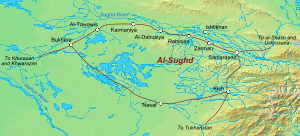Ishtakhaniyya

The Ishtakhaniyya (Arabic: الإشتاخنية al-Ishtākhaniyyah) were a regiment in the regular army of the Abbasid Caliphate during the ninth century. The regiment consisted of soldiers who were originally from the town and district of Ishtikhan in Transoxania.[1] The exact name of the Ishtakhaniyya is given variously in the sources, with the forms Ishtikhaniyya (Arabic: الإشتاخنية al-Ishtīkhaniyyah) and Ishtakhanjiyya (Arabic: الإشتاخنجية al-Ishtākhanjiyyah) presumably being variant names for the unit.[2]
History
The Ishtakhaniyya appear to have been active during the mid-ninth century, especially in the period when the Abbasid caliphs resided at Samarra. Compared to other Transoxanian regiments in the army such as the Faraghina or the Ushrusaniyya, however, they are infrequently mentioned in the sources.[3] During the caliphate of al-Mu'tasim (r. 833–842), the Ishtakhaniyya were, along with the other units of the army, stationed in Samarra after its construction in 836; al-Ya'qubi mentions that the officers of the Faraghina, Ushrusaniyya, Ishtakhanjiyya and other units from Khurasan resided along the city avenue called Shari' al-Hayr al-Jadid.[4]
In 845 the Ishtakhaniyya may have participated in Bugha al-Kabir's campaign against the disorderly Banu Sulaym in the vicinity of Medina.[5] In 870 they were one of several army units that attempted to defend the caliph al-Muhtadi (r. 869–870) against the rebellion of the Turkish troops.[6] After 870 the Ishtakhaniyya largely disappear in the sources; it is possible that the unit was disbanded during the caliphate of al-Mu'tamid (r. 870–892).[7]
Notes
- ↑ Bosworth, 462; Gordon, pp. 37, 185 n. 248
- ↑ Gordon, p. 188 n. 310; Northedge, p. 170 n. 613
- ↑ Gordon, p. 37. Shaban, p. 63, theorized that the relatively small number of references to the Ishtakhaniyya may have been due to "...such groups as the Ishtakhanjiyya, the Isbijabbiya and groups from similar localities who were in small numbers at first, were lumped together under the general term Turks, because of the obvious difficulties the Arabs had in pronouncing such foreign names."
- ↑ Northedge, pp. 120, 170; al-Ya'qubi, pp. 262-63
- ↑ Al-Tabari, v. 34: p. 50. The text reads "al-Ushrusaniyyah al-Ishtikhaniyya;" in Kraemer's opinion, "perhaps the word 'and'" should be inserted between the two names. Kraemer, n. 186
- ↑ Al-Tabari, v. 36: p. 107
- ↑ Kennedy, p. 150
References
- Bosworth, C.E. "Ishtikhan." The Encyclopedia of Islam, Volume XII: Supplement. New Ed. Leiden: E.J. Brill, 2004. ISBN 90-04-13974-5
- Gordon, Matthew S. The Breaking of a Thousand Swords: A History of the Turkish Military of Samarra (A.H. 200-275/815-889 C.E.). Albany, NY: State University of New York Press, 2001. ISBN 0-7914-4795-2
- Kennedy, Hugh. The Armies of the Caliphs: Military and Society in the Early Islamic State. New York: Routledge, 2001. ISBN 0-415-25093-5
- Kraemer, Joel L., trans. The History of al-Tabari, Volume XXXIV: Incipient Decline. By al-Tabari. Ed. Ehsan Yar-Shater. Albany, NY: State University of New York Press, 1989. ISBN 0-88706-874-X
- Northedge, Alastair. The Historical Topography of Samarra. London: The British School of Archeology in Iraq, 2005. ISBN 0-903472-17-1.
- Shaban, M.A. Islamic History: A New Interpretation, Vol. 2: A.D. 750-1055 (A.H. 132-448). Cambridge: Press Syndicate of the University of Cambridge, 1976. ISBN 0-521-21198-0
- Al-Tabari, Abu Ja'far Muhammad ibn Jarir. The History of al-Tabari. Ed. Ehsan Yar-Shater. 40 vols. Albany, NY: State University of New York Press, 1985-2007.
- Al-Ya'qubi, Ahmad ibn Abu Ya'qub. Kitab al-Buldan. Ed. M.J. de Goeje. 2nd ed. Leiden: E.J. Brill, 1892.